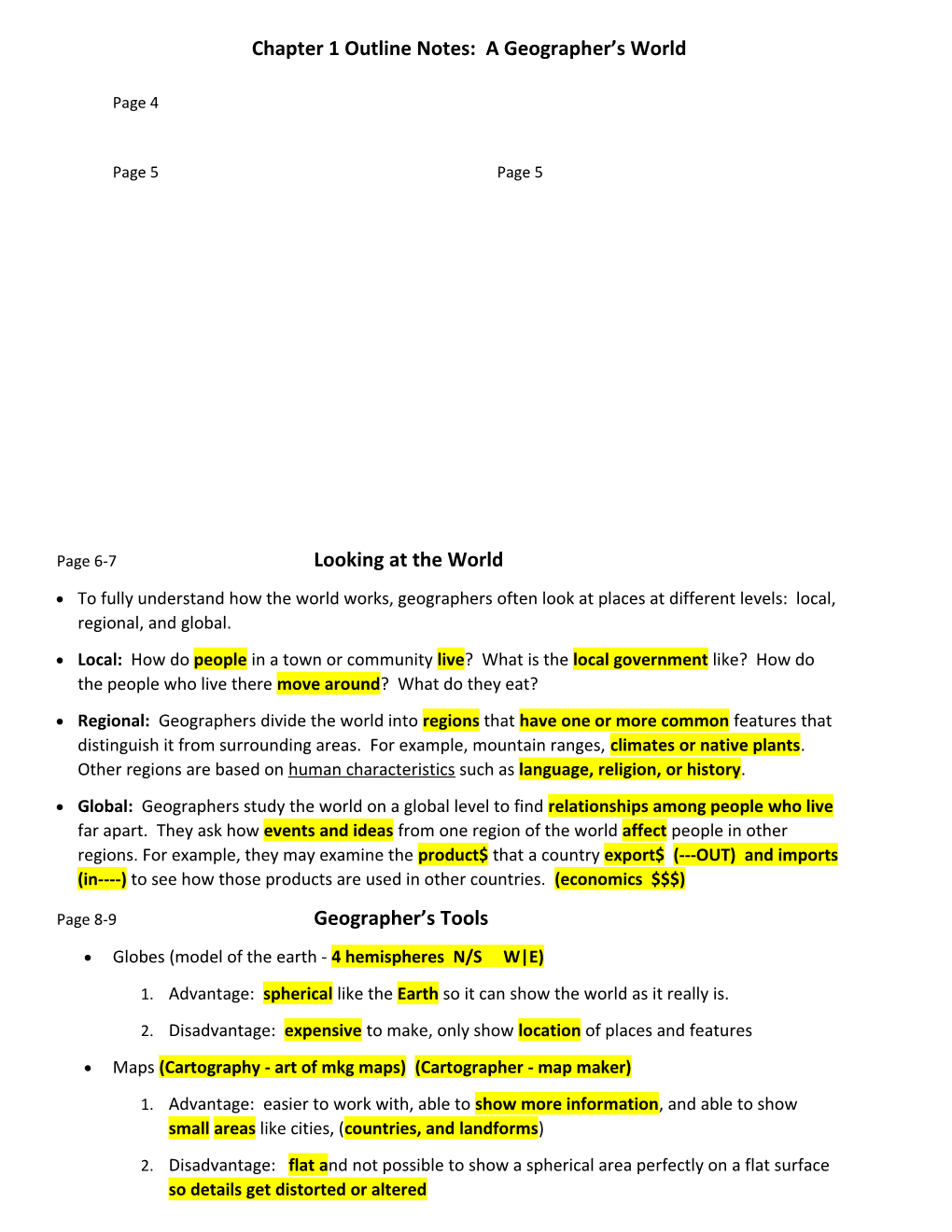Chapter 1 Outline Notes: A Geographer’s World
Page 4
Page 5 Page 5
Page 6-7 Looking at the World
- To fully understand how the world works, geographers often look at places at different levels: local, regional, and global.
- Local: How do people in a town or community live? What is the local government like? How do the people who live there move around? What do they eat?
- Regional: Geographers divide the world into regions that have one or more common features that distinguish it from surrounding areas. For example, mountain ranges, climates or native plants. Other regions are based on human characteristics such as language, religion, or history.
- Global: Geographers study the world on a global level to find relationships among people who livefar apart. They ask how events and ideas from one region of the world affect people in other regions.For example, they may examine the product$ that a country export$ (---OUT) and imports (in----)to see how those products are used in other countries. (economics $$$)
Page 8-9 Geographer’s Tools
- Globes (model of the earth - 4 hemispheres N/S W|E)
- Advantage: spherical like the Earthso it can show the world as it really is.
- Disadvantage: expensiveto make, only show locationof places and features
- Maps (Cartography - art of mkg maps) (Cartographer - map maker)
- Advantage: easier to work with, able to show more information, and able to show smallareas like cities, (countries, and landforms)
- Disadvantage: flat and not possible to show a spherical area perfectly on a flat surface so details get distorted or altered
- Satellite Images: information is in the form of imagesgathered from satellitesorbiting above the Earth and helps geographers make accurate maps(cartographers)
Five Themes of Geography
Theme / Description - Question(s) / Example / Give an example for your area
Location / Describes where something is using either
Absolute (lat N/S,long E|W) or relative location (compare).
Where is it? / Example: the White House is located at 1600 Pennsylvania Ave or Canada is north of the United States
Place / Refers to the area’s landscape, the features that make it different from other places. What do you see when you get there? / Examples; land, climate, people
Region / Areas that share common characteristics
What does it have in common? / Example: Mojave Desert is defined by its distinctive climate and plant life.
Movement / How and why people and things and IDEAS move. How do people, goods and ideas get around? / Example: Airports help people move around the world.
Human-Environment Interaction / How people and their physical environment (land, water, climate, plants, and animals) affect each other.
How do they interact? - goes both ways / Example: clear forest to plant crops, level fields to build cities, and dam rivers to prevent floods or build houses with thick walls and wear heavy clothing to keep warm. / Recycling - reduce, reuse and recycle
Air, water, natural resources adding to, taking from, pollution, deforestation, desalinization
Branches of Geography
Other branches of geography:
- Cartography – the science of making maps. Computer mapping allows geographers to make maps quickly and easily.
- Hydrology – the study of water on Earth. Hydroelectric energy.
- Meteorology – the study of weather and what causes it.
